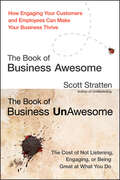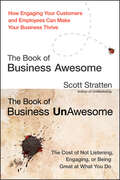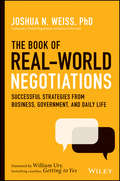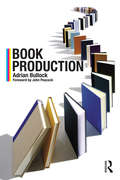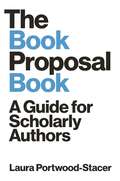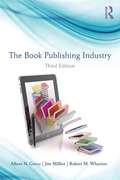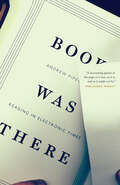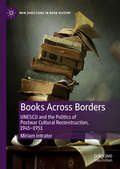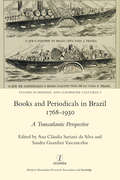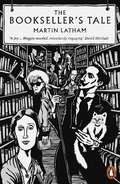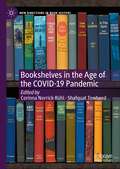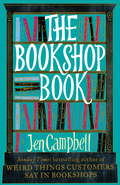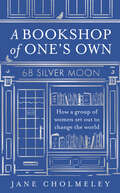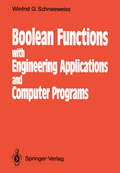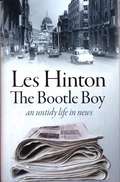- Table View
- List View
The Book of Business Awesome / The Book of Business UnAwesome
by Scott Stratten Alison KramerUnAwesome is UnAcceptable. The Book of Business Awesome is designed as two short books put together—one read from the front and the other read from the back when flipped over. Covering key business concepts related to marketing, branding, human resources, public relations, social media, and customer service, The Book of Business Awesome includes case studies of successful businesses that gained exposure through being awesome and effective. This book provides actionable tools enabling readers to apply the concepts immediately to their own businesses. The flip side of the book, The Book of Business UnAwesome, shares the train-wreck stories of unsuccessful businesses and showcases what not to do. Key concepts include the power of peripheral referrals and how to create content for your "third circle" Explains how to re-recruiting your employees and re-court your customers Ensure that your business remains awesome, instead of unawesome, and apply these awesomely effective strategies to your business today.
The Book of Business Awesome / The Book of Business UnAwesome
by Scott Stratten Alison KramerUnAwesome is UnAcceptable. The Book of Business Awesome is designed as two short books put together—one read from the front and the other read from the back when flipped over. Covering key business concepts related to marketing, branding, human resources, public relations, social media, and customer service, The Book of Business Awesome includes case studies of successful businesses that gained exposure through being awesome and effective. This book provides actionable tools enabling readers to apply the concepts immediately to their own businesses. The flip side of the book, The Book of Business UnAwesome, shares the train-wreck stories of unsuccessful businesses and showcases what not to do. Key concepts include the power of peripheral referrals and how to create content for your "third circle" Explains how to re-recruiting your employees and re-court your customers Ensure that your business remains awesome, instead of unawesome, and apply these awesomely effective strategies to your business today.
The Book of Real-World Negotiations: Successful Strategies From Business, Government, and Daily Life
by Joshua N. WeissReal world negotiation examples and strategies from one of the most highly respected authorities in the field This unique book can help you change your approach to negotiation by learning key strategies and techniques from actual cases. Through hard to find real world examples you will learn exactly how to effectively and productively negotiate. The Book of Real World Negotiations: Successful Strategies from Business, Government and Daily Life shines a light on real world negotiation examples and cases, rather than discussing hypothetical scenarios. It reveals what is possible through preparation, persistence, creativity, and taking a strategic approach to your negotiations. Many of us enter negotiations with skepticism and without understanding how to truly negotiate well. Because we lack knowledge and confidence, we may abandon the negotiating process prematurely or agree to deals that leave value on the table. The Book of Real World Negotiations will change that once and for all by immersing you in these real world scenarios. As a result, you’ll be better able to grasp the true power of negotiation to deal with some of the most difficult problems you face or to put together the best deals possible. This book also shares critical insights and lessons for instructors and students of negotiation, especially since negotiation is now being taught in virtually all law schools, many business schools, and in the field of conflict resolution. Whether you’re a student, instructor, or anyone who wants to negotiate successfully, you’ll be able to carefully examine real world negotiation situations that will show you how to achieve your objectives in the most challenging of circumstances. The cases are organized by realms—domestic business cases, international business cases, governmental cases and cases that occur in daily life. From these cases you will learn more about: Exactly how to achieve Win-Win outcomes The critical role of underlying interests The kind of thinking that goes into generating creative options How to consider your and the other negotiator’s Best Alternative to a Negotiated Agreement (BATNA) Negotiating successfully in the face of power Achieving success when negotiating cross-culturally Once you come to understand through these cases that negotiation is the art of the possible, you’ll stop saying "a solution is impossible." With the knowledge and self-assurance you gain from this book, you’ll roll up your sleeves and keep negotiating until you reach a mutually satisfactory outcome!
The Book of Real-World Negotiations: Successful Strategies From Business, Government, and Daily Life
by Joshua N. WeissReal world negotiation examples and strategies from one of the most highly respected authorities in the field This unique book can help you change your approach to negotiation by learning key strategies and techniques from actual cases. Through hard to find real world examples you will learn exactly how to effectively and productively negotiate. The Book of Real World Negotiations: Successful Strategies from Business, Government and Daily Life shines a light on real world negotiation examples and cases, rather than discussing hypothetical scenarios. It reveals what is possible through preparation, persistence, creativity, and taking a strategic approach to your negotiations. Many of us enter negotiations with skepticism and without understanding how to truly negotiate well. Because we lack knowledge and confidence, we may abandon the negotiating process prematurely or agree to deals that leave value on the table. The Book of Real World Negotiations will change that once and for all by immersing you in these real world scenarios. As a result, you’ll be better able to grasp the true power of negotiation to deal with some of the most difficult problems you face or to put together the best deals possible. This book also shares critical insights and lessons for instructors and students of negotiation, especially since negotiation is now being taught in virtually all law schools, many business schools, and in the field of conflict resolution. Whether you’re a student, instructor, or anyone who wants to negotiate successfully, you’ll be able to carefully examine real world negotiation situations that will show you how to achieve your objectives in the most challenging of circumstances. The cases are organized by realms—domestic business cases, international business cases, governmental cases and cases that occur in daily life. From these cases you will learn more about: Exactly how to achieve Win-Win outcomes The critical role of underlying interests The kind of thinking that goes into generating creative options How to consider your and the other negotiator’s Best Alternative to a Negotiated Agreement (BATNA) Negotiating successfully in the face of power Achieving success when negotiating cross-culturally Once you come to understand through these cases that negotiation is the art of the possible, you’ll stop saying "a solution is impossible." With the knowledge and self-assurance you gain from this book, you’ll roll up your sleeves and keep negotiating until you reach a mutually satisfactory outcome!
Book Production
by Adrian BullockThe digital revolution has brought with it a wider range of options for creating and producing print on paper products than ever seen before. With the growing demand for skills and knowledge with which to exploit the potential of digital technology, comes the need for a comprehensive book that not only makes it possible for production staff, editors, and designers to understand how the technology affects the industry they work in, but also provides them with the skills and competencies they need to work in it smartly and effectively. This book is designed to satisfy this need. Book Production falls into two parts: The first part deals with the increasingly important role of production as project managers, a role which has not been adequately written about in any of the recent literature on publishing. The second part deals with the processes and raw materials used in developing and manufacturing print on paper products. Case studies are used to illustrate why and how some processes or raw materials may or may not be appropriate for a particular job. With expert opinions and case studies, and a consideration of the practices and issues involved, this offers a comprehensive overview of book production for anyone working, or training to work in or in conjunction with the books industry.
Book Production
by Adrian BullockThe digital revolution has brought with it a wider range of options for creating and producing print on paper products than ever seen before. With the growing demand for skills and knowledge with which to exploit the potential of digital technology, comes the need for a comprehensive book that not only makes it possible for production staff, editors, and designers to understand how the technology affects the industry they work in, but also provides them with the skills and competencies they need to work in it smartly and effectively. This book is designed to satisfy this need. Book Production falls into two parts: The first part deals with the increasingly important role of production as project managers, a role which has not been adequately written about in any of the recent literature on publishing. The second part deals with the processes and raw materials used in developing and manufacturing print on paper products. Case studies are used to illustrate why and how some processes or raw materials may or may not be appropriate for a particular job. With expert opinions and case studies, and a consideration of the practices and issues involved, this offers a comprehensive overview of book production for anyone working, or training to work in or in conjunction with the books industry.
The Book Proposal Book: A Guide for Scholarly Authors (Skills for Scholars)
by Laura Portwood-StacerA step-by-step guide to crafting a compelling scholarly book proposal—and seeing your book through to successful publicationThe scholarly book proposal may be academia’s most mysterious genre. You have to write one to get published, but most scholars receive no training on how to do so—and you may have never even seen a proposal before you’re expected to produce your own. The Book Proposal Book cuts through the mystery and guides prospective authors step by step through the process of crafting a compelling proposal and pitching it to university presses and other academic publishers.Laura Portwood-Stacer, an experienced developmental editor and publishing consultant for academic authors, shows how to select the right presses to target, identify audiences and competing titles, and write a project description that will grab the attention of editors—breaking the entire process into discrete, manageable tasks. The book features over fifty time-tested tips to make your proposal stand out; sample prospectuses, a letter of inquiry, and a response to reader reports from real authors; optional worksheets and checklists; answers to dozens of the most common questions about the scholarly publishing process; and much, much more.Whether you’re hoping to publish your first book or you’re a seasoned author with an unfinished proposal languishing on your hard drive, The Book Proposal Book provides honest, empathetic, and invaluable advice on how to overcome common sticking points and get your book published. It also shows why, far from being merely a hurdle to clear, a well-conceived proposal can help lead to an outstanding book.
The Book Proposal Book: A Guide for Scholarly Authors (Skills for Scholars)
by Laura Portwood-StacerA step-by-step guide to crafting a compelling scholarly book proposal—and seeing your book through to successful publicationThe scholarly book proposal may be academia’s most mysterious genre. You have to write one to get published, but most scholars receive no training on how to do so—and you may have never even seen a proposal before you’re expected to produce your own. The Book Proposal Book cuts through the mystery and guides prospective authors step by step through the process of crafting a compelling proposal and pitching it to university presses and other academic publishers.Laura Portwood-Stacer, an experienced developmental editor and publishing consultant for academic authors, shows how to select the right presses to target, identify audiences and competing titles, and write a project description that will grab the attention of editors—breaking the entire process into discrete, manageable tasks. The book features over fifty time-tested tips to make your proposal stand out; sample prospectuses, a letter of inquiry, and a response to reader reports from real authors; optional worksheets and checklists; answers to dozens of the most common questions about the scholarly publishing process; and much, much more.Whether you’re hoping to publish your first book or you’re a seasoned author with an unfinished proposal languishing on your hard drive, The Book Proposal Book provides honest, empathetic, and invaluable advice on how to overcome common sticking points and get your book published. It also shows why, far from being merely a hurdle to clear, a well-conceived proposal can help lead to an outstanding book.
The Book Publishing Industry (Mass Communications Book Ser.)
by Albert N. GrecoThe Book Publishing Industry focuses on consumer books (adult, juvenile, and mass market paperbacks) and reviews all major book categories to present a comprehensive overview of this diverse business. In addition to the insights and portrayals of the U.S. publishing industry, this book includes an appendix containing historical data on the industry from 1946 to the end of the twentieth century. The selective bibliography includes the latest literature, including works in marketing and economics that has a direct relationship with this dynamic industry. This third edition features a chapter on e-books and provides an overview of the current shift toward digital media in the US book publishing industry.
The Book Publishing Industry
by Albert N. GrecoThe Book Publishing Industry focuses on consumer books (adult, juvenile, and mass market paperbacks) and reviews all major book categories to present a comprehensive overview of this diverse business. In addition to the insights and portrayals of the U.S. publishing industry, this book includes an appendix containing historical data on the industry from 1946 to the end of the twentieth century. The selective bibliography includes the latest literature, including works in marketing and economics that has a direct relationship with this dynamic industry. This third edition features a chapter on e-books and provides an overview of the current shift toward digital media in the US book publishing industry.
Book Was There: Reading in Electronic Times
by Andrew PiperAndrew Piper grew up liking books and loving computers. While occasionally burying his nose in books, he was going to computer camp, programming his Radio Shack TRS-80, and playing Pong. His eventual love of reading made him a historian of the book and a connoisseur of print, but as a card-carrying member of the first digital generation—and the father of two digital natives—he understands that we live in electronic times. Book Was There is Piper’s surprising and always entertaining essay on reading in an e-reader world. Much ink has been spilled lamenting or championing the decline of printed books, but Piper shows that the rich history of reading itself offers unexpected clues to what lies in store for books, print or digital. From medieval manuscript books to today’s playable media and interactive urban fictions, Piper explores the manifold ways that physical media have shaped how we read, while also observing his own children as they face the struggles and triumphs of learning to read. In doing so, he uncovers the intimate connections we develop with our reading materials—how we hold them, look at them, share them, play with them, and even where we read them—and shows how reading is interwoven with our experiences in life. Piper reveals that reading’s many identities, past and present, on page and on screen, are the key to helping us understand the kind of reading we care about and how new technologies will—and will not—change old habits. Contending that our experience of reading belies naive generalizations about the future of books, Book Was There is an elegantly argued and thoroughly up-to-date tribute to the endurance of books in our ever-evolving digital world.
Book Was There: Reading in Electronic Times
by Andrew PiperAndrew Piper grew up liking books and loving computers. While occasionally burying his nose in books, he was going to computer camp, programming his Radio Shack TRS-80, and playing Pong. His eventual love of reading made him a historian of the book and a connoisseur of print, but as a card-carrying member of the first digital generation—and the father of two digital natives—he understands that we live in electronic times. Book Was There is Piper’s surprising and always entertaining essay on reading in an e-reader world. Much ink has been spilled lamenting or championing the decline of printed books, but Piper shows that the rich history of reading itself offers unexpected clues to what lies in store for books, print or digital. From medieval manuscript books to today’s playable media and interactive urban fictions, Piper explores the manifold ways that physical media have shaped how we read, while also observing his own children as they face the struggles and triumphs of learning to read. In doing so, he uncovers the intimate connections we develop with our reading materials—how we hold them, look at them, share them, play with them, and even where we read them—and shows how reading is interwoven with our experiences in life. Piper reveals that reading’s many identities, past and present, on page and on screen, are the key to helping us understand the kind of reading we care about and how new technologies will—and will not—change old habits. Contending that our experience of reading belies naive generalizations about the future of books, Book Was There is an elegantly argued and thoroughly up-to-date tribute to the endurance of books in our ever-evolving digital world.
Book Was There: Reading in Electronic Times
by Andrew PiperAndrew Piper grew up liking books and loving computers. While occasionally burying his nose in books, he was going to computer camp, programming his Radio Shack TRS-80, and playing Pong. His eventual love of reading made him a historian of the book and a connoisseur of print, but as a card-carrying member of the first digital generation—and the father of two digital natives—he understands that we live in electronic times. Book Was There is Piper’s surprising and always entertaining essay on reading in an e-reader world. Much ink has been spilled lamenting or championing the decline of printed books, but Piper shows that the rich history of reading itself offers unexpected clues to what lies in store for books, print or digital. From medieval manuscript books to today’s playable media and interactive urban fictions, Piper explores the manifold ways that physical media have shaped how we read, while also observing his own children as they face the struggles and triumphs of learning to read. In doing so, he uncovers the intimate connections we develop with our reading materials—how we hold them, look at them, share them, play with them, and even where we read them—and shows how reading is interwoven with our experiences in life. Piper reveals that reading’s many identities, past and present, on page and on screen, are the key to helping us understand the kind of reading we care about and how new technologies will—and will not—change old habits. Contending that our experience of reading belies naive generalizations about the future of books, Book Was There is an elegantly argued and thoroughly up-to-date tribute to the endurance of books in our ever-evolving digital world.
Book Was There: Reading in Electronic Times
by Andrew PiperAndrew Piper grew up liking books and loving computers. While occasionally burying his nose in books, he was going to computer camp, programming his Radio Shack TRS-80, and playing Pong. His eventual love of reading made him a historian of the book and a connoisseur of print, but as a card-carrying member of the first digital generation—and the father of two digital natives—he understands that we live in electronic times. Book Was There is Piper’s surprising and always entertaining essay on reading in an e-reader world. Much ink has been spilled lamenting or championing the decline of printed books, but Piper shows that the rich history of reading itself offers unexpected clues to what lies in store for books, print or digital. From medieval manuscript books to today’s playable media and interactive urban fictions, Piper explores the manifold ways that physical media have shaped how we read, while also observing his own children as they face the struggles and triumphs of learning to read. In doing so, he uncovers the intimate connections we develop with our reading materials—how we hold them, look at them, share them, play with them, and even where we read them—and shows how reading is interwoven with our experiences in life. Piper reveals that reading’s many identities, past and present, on page and on screen, are the key to helping us understand the kind of reading we care about and how new technologies will—and will not—change old habits. Contending that our experience of reading belies naive generalizations about the future of books, Book Was There is an elegantly argued and thoroughly up-to-date tribute to the endurance of books in our ever-evolving digital world.
Book Was There: Reading in Electronic Times
by Andrew PiperAndrew Piper grew up liking books and loving computers. While occasionally burying his nose in books, he was going to computer camp, programming his Radio Shack TRS-80, and playing Pong. His eventual love of reading made him a historian of the book and a connoisseur of print, but as a card-carrying member of the first digital generation—and the father of two digital natives—he understands that we live in electronic times. Book Was There is Piper’s surprising and always entertaining essay on reading in an e-reader world. Much ink has been spilled lamenting or championing the decline of printed books, but Piper shows that the rich history of reading itself offers unexpected clues to what lies in store for books, print or digital. From medieval manuscript books to today’s playable media and interactive urban fictions, Piper explores the manifold ways that physical media have shaped how we read, while also observing his own children as they face the struggles and triumphs of learning to read. In doing so, he uncovers the intimate connections we develop with our reading materials—how we hold them, look at them, share them, play with them, and even where we read them—and shows how reading is interwoven with our experiences in life. Piper reveals that reading’s many identities, past and present, on page and on screen, are the key to helping us understand the kind of reading we care about and how new technologies will—and will not—change old habits. Contending that our experience of reading belies naive generalizations about the future of books, Book Was There is an elegantly argued and thoroughly up-to-date tribute to the endurance of books in our ever-evolving digital world.
Book Was There: Reading in Electronic Times
by Andrew PiperAndrew Piper grew up liking books and loving computers. While occasionally burying his nose in books, he was going to computer camp, programming his Radio Shack TRS-80, and playing Pong. His eventual love of reading made him a historian of the book and a connoisseur of print, but as a card-carrying member of the first digital generation—and the father of two digital natives—he understands that we live in electronic times. Book Was There is Piper’s surprising and always entertaining essay on reading in an e-reader world. Much ink has been spilled lamenting or championing the decline of printed books, but Piper shows that the rich history of reading itself offers unexpected clues to what lies in store for books, print or digital. From medieval manuscript books to today’s playable media and interactive urban fictions, Piper explores the manifold ways that physical media have shaped how we read, while also observing his own children as they face the struggles and triumphs of learning to read. In doing so, he uncovers the intimate connections we develop with our reading materials—how we hold them, look at them, share them, play with them, and even where we read them—and shows how reading is interwoven with our experiences in life. Piper reveals that reading’s many identities, past and present, on page and on screen, are the key to helping us understand the kind of reading we care about and how new technologies will—and will not—change old habits. Contending that our experience of reading belies naive generalizations about the future of books, Book Was There is an elegantly argued and thoroughly up-to-date tribute to the endurance of books in our ever-evolving digital world.
Books Across Borders: UNESCO and the Politics of Postwar Cultural Reconstruction, 1945–1951 (New Directions in Book History)
by Miriam IntratorBooks Across Borders: UNESCO and the Politics of Postwar Cultural Reconstruction, 1945-1951 is a history of the emotional, ideological, informational, and technical power and meaning of books and libraries in the aftermath of World War II, examined through the cultural reconstruction activities undertaken by the Libraries Section of the United Nations Educational, Scientific and Cultural Organization (UNESCO). The book focuses on the key actors and on-the-ground work of the Libraries Section in four central areas: empowering libraries around the world to acquire the books they wanted and needed; facilitating expanded global production of quality translations and affordable books; participating in debates over the contested fate of confiscated books and displaced libraries; and formulating notions of cultural rights as human rights. Through examples from France, Poland, and surviving Jewish Europe, this book provides new insight into the complexities and specificities of UNESCO’s role in the realm of books, libraries, and networks of information exchange during the early postwar, post-Holocaust, Cold War years.
Books and Periodicals in Brazil 1768-1930
by AnaClaudiaSurianiDa SilvaBefore the Portuguese Royal Court moved to its South-American colony in 1808, books and periodicals had a very limited circulation there. It was only when Brazilian ports were opened to foreign trade that the book trade began to flourish, and printed matter became more easily available to readers, whether for pleasure, for instruction or for political reasons. This book brings together a collection of original articles on the transnational relations between Brazil and Europe, especially England and France, in the domain of literature and print culture from its early stages to the end of the 1920s. It covers the time when it was forbidden to print in Brazil, and Portugal strictly controlled which books were sent to the colony, through the quick flourishing of a transnational printing industry and book market after 1822, to the shift of hegemony in the printing business from foreign to Brazilian hands at the beginning of the twentieth century. Sandra Guardini Vasconcelos is Professor of English and Comparative Literature at the University of Sao Paulo.
Books and Periodicals in Brazil 1768-1930
by AnaClaudiaSurianiDa SilvaBefore the Portuguese Royal Court moved to its South-American colony in 1808, books and periodicals had a very limited circulation there. It was only when Brazilian ports were opened to foreign trade that the book trade began to flourish, and printed matter became more easily available to readers, whether for pleasure, for instruction or for political reasons. This book brings together a collection of original articles on the transnational relations between Brazil and Europe, especially England and France, in the domain of literature and print culture from its early stages to the end of the 1920s. It covers the time when it was forbidden to print in Brazil, and Portugal strictly controlled which books were sent to the colony, through the quick flourishing of a transnational printing industry and book market after 1822, to the shift of hegemony in the printing business from foreign to Brazilian hands at the beginning of the twentieth century. Sandra Guardini Vasconcelos is Professor of English and Comparative Literature at the University of Sao Paulo.
The Bookseller's Tale
by Martin Latham'The Bookseller's Tale is a joy. I read the first chapters in a single binge-read, and each chapter instantly became my favourite ... I loved this gnarly old bookshop in nifty book form' David Mitchell, author of Cloud Atlas'Entertaining, erudite, eccentric - a delight' Alison Light, author of Common People'The right book has a neverendingness, and so does the right bookshop.'This is the story of our love affair with books, whether we arrange them on our shelves, inhale their smell, scrawl in their margins or just curl up with them in bed. Taking us on a journey through comfort reads, street book stalls, mythical libraries, itinerant pedlars, radical pamphleteers, extraordinary bookshop customers and fanatical collectors, Canterbury bookseller Martin Latham uncovers the curious history of our book obsession - and his own. Part cultural history, part literary love letter and part reluctant memoir, this is the tale of one bookseller and many, many books.
Bookshelves in the Age of the COVID-19 Pandemic (New Directions in Book History)
by Corinna Norrick-Rühl Shafquat TowheedBookshelves in the Age of the COVID-19 Pandemic provides the first detailed scholarly investigation of the cultural phenomenon of bookshelves (and the social practices around them) since the start of the pandemic in March 2020. With a foreword by Lydia Pyne, author of Bookshelf (2016), the volume brings together 17 scholars from 6 countries (Australia, Canada, Germany, the Netherlands, the UK, and the USA) with expertise in literary studies, book history, publishing, visual arts, and pedagogy to critically examine the role of bookshelves during the current pandemic. This volume interrogates the complex relationship between the physical book and its digital manifestation via online platforms, a relationship brought to widespread public and scholarly attention by the global shift to working from home and the rise of online pedagogy. It also goes beyond the (digital) bookshelf to consider bookselling, book accessibility, and pandemic reading habits.
The Bookshop Book
by Jen CampbellWe're not talking about rooms that are just full of books. We're talking about bookshops in barns, disused factories, converted churches and underground car parks. Bookshops on boats, on buses, and in old run-down train stations. Fold-out bookshops, undercover bookshops, this-is-the-best-place-I've-ever-been-to-bookshops. Meet Sarah and her Book Barge sailing across the sea to France; meet Sebastien, in Mongolia, who sells books to herders of the Altai mountains; meet the bookshop in Canada that's invented the world's first antiquarian book vending machine. And that's just the beginning. From the oldest bookshop in the world, to the smallest you could imagine, The Bookshop Book examines the history of books, talks to authors about their favourite places, and looks at over three hundred weirdly wonderful bookshops across six continents (sadly, we've yet to build a bookshop down in the South Pole). The Bookshop Book is a love letter to bookshops all around the world. --"A good bookshop is not just about selling books from shelves, but reaching out into the world and making a difference." David Almond (The Bookshop Book includes interviews and quotes from David Almond, Ian Rankin, Tracy Chevalier, Audrey Niffenegger, Jacqueline Wilson, Jeanette Winterson and many, many others.)
A Bookshop of One’s Own: How A Group Of Women Set Out To Change The World
by Jane CholmeleyThe captivating true story of an underdog business – a feminist bookshop founded in Thatcher’s Britain – from a woman at the heart of the women’s liberation movement. An Independent and Stylist Best Non-Fiction Book for 2024
Boolean Functions: With Engineering Applications and Computer Programs
by Winfried G. SchneeweissModern systems engineering (e. g. switching circuits design) and operations research (e. g. reliability systems theory) use Boolean functions with increasing regularity. For practitioners and students in these fields books written for mathe maticians are in several respects not the best source of easy to use information, and standard books, such as, on switching circuits theory and reliability theory, are mostly somewhat narrow as far as Boolean analysis is concerned. Further more, in books on switching circuits theory the relevant stochastic theory is not covered. Aspects of the probabilistic theory of Boolean functions are treated in some works on reliability theory, but the results deserve a much broader interpre tation. Just as the applied theory (e. g. of the Laplace transform) is useful in control theory, renewal theory, queueing theory, etc. , the applied theory of Boolean functions (of indicator variables) can be useful in reliability theory, switching circuits theory, digital diagnostics and communications theory. This book is aimed at providing a sufficiently deep understanding of useful results both in practical work and in applied research. Boolean variables are restricted here to indicator or O/l variables, i. e. variables whose values, namely 0 and 1, are not free for a wide range of interpretations, e. g. in digital electronics 0 for L ==low voltage and 1 for H == high voltage.
The Bootle Boy: An Untidy Life In News
by Les HintonWhen Les Hinton first fulfils his schoolboy dream of working on Fleet Street, it is still a place awash in warm beer, black ink, fag ash, and hot metal. Fifty-two years after being sent out to buy a sandwich for his first boss, one Rupert Murdoch, when Les finally leaves Murdoch’s employment in 2011, the business of news has been turned upside down, in a tumble of social and technological change. Les Hinton has been present at and noiselessly directed several key scenes in that tale of revolutionary transformation, as employee and later head of Murdoch companies in newspapers, magazines, and television, on three continents over five decades, in Wapping and Wall Street, Australia and California. Born amid the rubble of the blitzed docklands of Bootle, and schooled by an itinerant Army childhood, he came to the centre from the periphery, just as Murdoch did. There, with a gang of like-minded outsiders, he set about redrawing the map of the media. Hinton depicts the upheavals that swept his trade with the same widescreen perspective and sharp colours he deploys to show us how politicians from Clinton to Blair, from Brown to Cameron, alternately canoodled and raged inside their arranged media marriages. We see the death of Diana, the IRA bombings, the charisma of Bill Clinton, and the phone-hacking scandal from a revelatory new angle. And we get the most undeluded and undiluted portrait yet of the man who is perhaps the last of the great press barons. Above all, emerging out of Hinton's scintillating stories of half a century of Murdoch and news revolutions, comes the voice of a wandering Liverpudlian who is still in love with the life of a newspaperman, and now the author of one of the defining media memoirs of our age.
